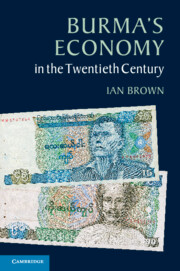Book contents
- Frontmatter
- Dedication
- Contents
- List of Illustrations
- List of Tables
- Note on names
- Acknowledgements
- Map of Burma/Myanmar
- Introduction
- 1 The economy at the beginning of the twentieth century
- 2 Strains in the late colonial economy
- 3 War and independence
- 4 In pursuit of socialism
- 5 Toward the market: the economy from 1988
- Conclusion: themes and threads
- Bibliography
- Index
- References
3 - War and independence
Published online by Cambridge University Press: 05 June 2014
- Frontmatter
- Dedication
- Contents
- List of Illustrations
- List of Tables
- Note on names
- Acknowledgements
- Map of Burma/Myanmar
- Introduction
- 1 The economy at the beginning of the twentieth century
- 2 Strains in the late colonial economy
- 3 War and independence
- 4 In pursuit of socialism
- 5 Toward the market: the economy from 1988
- Conclusion: themes and threads
- Bibliography
- Index
- References
Summary
War and the end of British rule
From the outbreak of war in South East Asia in early December 1941, it took the Japanese just six months to drive the British from Burma, although in truth, the British fate was settled long before the final end. On 15 December, a week or so after the attack on Pearl Harbor, Japanese troops crossed the border from Siam and seized Burma's most southern town, Victoria Point, and, crucially, its airfield. From there, the Japanese put out of action the airfields to the north at Mergui and Tavoy, opening the way for the further advance of Japanese forces from the south-east and towards Rangoon. On 23 December, Rangoon was bombed from the air, causing considerable casualties – some 2,000 were killed in the attack and many injured – and extensive physical destruction. Thousands of Indians, the labourers, menials, traders, and shopkeepers without whom Rangoon could not function, fled the city. Two days later, on Christmas Day 1941, Rangoon was again bombed. Then, in mid-January 1942, the main Japanese force, accompanied by units of the newly formed Burma Independence Army, crossed the border from Siam from the south-east. The first major objective of the Japanese force, the port of Moulmein at the mouth of the Salween, fell on 31 January. And then in late February, the British Seventeenth Indian Division, falling back to a position to hold the advancing Japanese, was caught at the Sittang Bridge. When the order was given to destroy the bridge, to deny the crossing to the Japanese, ten of the division's twelve battalions were left on the wrong side of the river.
- Type
- Chapter
- Information
- Burma's Economy in the Twentieth Century , pp. 80 - 130Publisher: Cambridge University PressPrint publication year: 2013
References
- 1
- Cited by



